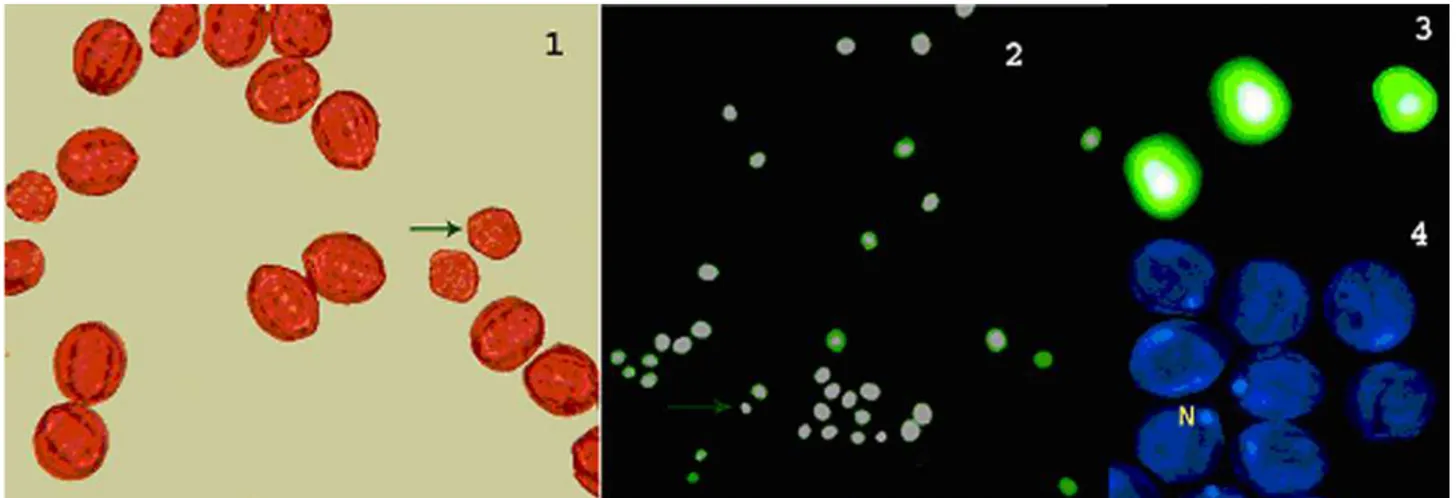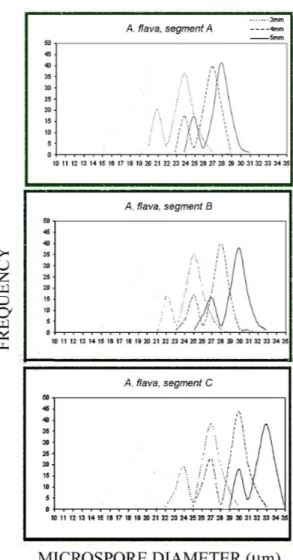Variability of size in uninucleate microspores was observed in yellow buckeye (Aesculus flava Marshall). Microspores were iso-lated from closed flower buds (3, 4 and 5 mm) and different seg-ments (A, B and C) of inflorescences. Investigation of bimodal distribution confirmed the presence of pollen dimorphism in all types of flowers.
Aesculus flava (syn. A. octandra) is a species of buckeye native to eastern North America, from Pennsylvania, west to eastern Illinois, and south to the northernmost parts of Alabama and Georgia. Pollen dimorphism has been detected in anthers of some woody species. Uninuclear microspores isolated from closed flower buds in horse chestnut (R a d o j e v i ć , 1989, 1991; Ć a l i ć et al., 2003/4) and red chestnut (M a r i n k o v i ć and R a d o j e v i ć , 1992) showed differences in size, shape, stain-ing intensity, fluorescence, viability, and embryogenic potential (R a d o j e v i ć et al., 2000). Moreover, pollen orginating from 13 species of the genus Aesculus showed differences in size and shape, pore position, sculpturing of the colpal membrane, and sculpturing of the mesocolpia (P o z h i d a e v, 1995). The small yellow-green inflorescence of Aesculus flava is about 17 cm long and 7 cm wide. Composed of an upright panicle of many solitary flowers, it appears in mid-May, the inflorescence clearly rising above the expanded foliage.
As in flowers of Aesculus hippocastanum, A. flava flowers located in the basal part of the panicle are female and fertile, while flowers in the middle are bisexual and those on the top are male (H e y w o o d , 1978).
The female flowers (segment A) have pistils and stamens, but the stamens peak prematurely and the anthers do not open, while bisexual flowers (segment B) have normally developed and functional pistils and stamens.
The male flowers (segment C) have undeveloped pistils and never form fruits (H e y w o o d , 1978).
Uninuclear microspores were isolated from closed flower buds of different size (3, 4, and 5 mm) orginating from inflo-rescence segments A, B, and C. Anthers were resected and free microspores were stained with 1% orcein solutions prepared in 45% acetic acid (Fig. 1). Three hundred microspores were analyzed from each closed flower bud. Aceto-orcein-treated microspores were a DMRB microscope from Leica (Wetzlar, Germany) and analyzed with the Image Tool software program (version 3.0) from UTHSCSA (San Antonio, USA). The results were analyzed using a completely randomized design.
VARIABILITY AND BIMODAL DISTRIBUTION OF SIZE IN UNINUCLEAR MICROSPORES OF
AESCULUS FLAVA
MARSHALL. Dušica Ćalić-Dragosavac
1, Danijela Pemac
2, Ivana Dragićević
3,
and
Ljiljana Radojević
1.
1Department of Plant Physiology
and
2Department of Evolutionary Biology, Siniša
Stanković Institute for Biological Research
, 11060 Belgrade, Serbia;
3Institute of Botany, Faculty of Biology,
University of Belgrade,
11000 Belgrade, Serbia.
UDC 581.33:582.766.5:575
3P
Arch. Biol. Sci., Belgrade, 60 (1), 3P-4P, 2008 DOI:10.2298/ABS080103PC
Keywords: Yellow buckeye, pollen dimorphism, microspore diameter
Flower buds 3 mm in length contained significantly smaller microspores than 4- and 5-mm-long flower buds in all (A-C) segments of the inflorescence. Independent of bud size, the smallest microspores (from 23.85 to 28.34 µm) were in segment A, the largest (from 27.18 to 33.32 µm) in segment C. In addi-tion, average microspore size varied by about 10 µm, depending on bud size and segment. Microspores of A. flava have shorter and longer diameters in all the investigated flower buds. It has been suggested that uninuclear microspores of A. flava, like microspores of A. hippocastanum (R a d o j e v i ć , 1989, 1991; Ć a l i ć et al., 2003/4), can be grouped in two classes: small, lightly staining (with aceto-orceine and fluorescein-diacetate); and large, densely staining (Figs. 1, 2, and 3). Small uninuclear microspores (Fig. 4) are androgenic, while large ones are non-androgenic (R a d o j e v i ć , 1989, 1991). Variability of microspore size was confirmed by the presence of a bimodal distribution, with lower and higher peaks (Fig. 5). The two characacteristic peaks had different values for microspores derived from flower buds of the same length, but originating from different segments. The presence variability and a bimodal distribution of size in uninuclear microspores of A. flava (Fig. 5) is in agreement with the results of N ä g e l i (1998) and Ć a l i ć et al. (2003/4).
Acknowledgment - his study was inancially supported by the Serbian Ministry of Science and Environmental Protection (Grant 143026).
References: - Ćalić, D., Zdravković-Korać, S., Pemac, D., and Lj. Radojević (2003/4). Biol. Plant. 47, 457-458. - Nageli, M. (1998): Ph. D. Thesis No.12808. ETH, Zürich. - Heywood, V. H. (1978). In: Heywood,V. H. (Ed.), Flowering plants in the World, 194-196. Oxford – London - Melbourne. - Marinković, N., Lj. Radojević (1992). Plant Cell Tissue Organ Cult. 31, 51-59. - Pozhidaev, A. E. (1995). Grana 4, 10-20. - Radojević, Lj. (1989). Arch. Biol. Sci. (Belgrade) 41, 137-143. - Radojević, Lj. (1991). In: Bajaj, Y. P. S. (Ed.), Biotechnology in Agriculture and Forestry, 111-141. Springer – Verlag, Berlin – Heidelberg. - Radojević, Lj., Marinković, N., and S. Jevremović (2000). In Vitro Cell Dev. Biol. Plant. 36, 464-469.
4P

